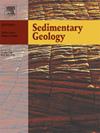Introducing a water activity coefficient to account for abundance and isotopic compositions of gypsum and halite in the Mediterranean's salt giant deposit
IF 2.9
2区 地球科学
Q1 GEOLOGY
引用次数: 0
Abstract
A simple box model is developed to access the astronomical-modulated exchange of ocean seawater with the Mediterranean during the Late Miocene salinity crisis. The model differs from previous ones by using a unidirectional portal as the method to get salinity to increase to saturation for gypsum and halite. Flow through the entry portal switches in direction as climate oscillates from arid to wet during each precession cycle. The calculations incorporate a water activity coefficient that reduces the rate of evaporation as salinity increases. As a result, the accumulation rate of gypsum and halite declines with time. The sodium, sulfate, potassium and magnesium ions observed from fluid inclusions in gypsum and halite are replicated in the model. The reduction in input from the exterior ocean and eventual closure of the gateway conforms with the sedimentological and geochemical behavior of the gypsum deposits on margins and halite in salt mines and reflection profiles. By showing that rain and rivers supply eight times more water to the Mediterranean brine than seawater during the hypersaline stage of the Late Miocene salinity crisis, the calculations resolve the geochemical riddle of “low salinity gypsum”. The sulfur isotopes in gypsum derive from ocean seawater and the oxygen and hydrogen isotopes in the gypsum hydration water from atmospheric precipitation.
引入水活度系数来解释地中海盐巨矿床中石膏和岩盐的丰度和同位素组成
在晚中新世盐度危机期间,建立了一个简单的箱形模型来模拟天文调制的海洋海水与地中海的交换。该模型与以往模型的不同之处在于,该模型采用了单向入口作为使石膏和岩盐的盐度增加到饱和的方法。在每个岁差循环中,随着气候从干旱到潮湿的变化,通过入口的水流会改变方向。计算中包含了水活度系数,该系数随着盐度的增加降低了蒸发速率。石膏和岩盐的富集速率随时间的延长而降低。从石膏和岩盐中的流体包裹体中观察到的钠、硫酸盐、钾和镁离子在模型中得到了复制。外部海洋输入的减少和入口的最终关闭符合边缘石膏矿床和盐矿岩盐的沉积学和地球化学行为和反射剖面。通过表明在晚中新世盐度危机的高盐度阶段,雨水和河流向地中海盐水提供的水量是海水的8倍,计算解决了“低盐度石膏”的地球化学之谜。石膏中的硫同位素来源于海洋海水,石膏水化水中的氧、氢同位素来源于大气降水。
本文章由计算机程序翻译,如有差异,请以英文原文为准。
求助全文
约1分钟内获得全文
求助全文
来源期刊

Sedimentary Geology
地学-地质学
CiteScore
5.10
自引率
7.10%
发文量
133
审稿时长
32 days
期刊介绍:
Sedimentary Geology is a journal that rapidly publishes high quality, original research and review papers that cover all aspects of sediments and sedimentary rocks at all spatial and temporal scales. Submitted papers must make a significant contribution to the field of study and must place the research in a broad context, so that it is of interest to the diverse, international readership of the journal. Papers that are largely descriptive in nature, of limited scope or local geographical significance, or based on limited data will not be considered for publication.
 求助内容:
求助内容: 应助结果提醒方式:
应助结果提醒方式:


